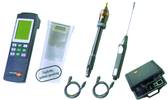

Advances in humidity sensor technology by leading European manufacturers makes the measurement of humidity under harsher conditions possible. Dieter Bütow, Sales & Marketing Manager of UniTemp, provides an overview on the new possibilities and applications.
New sensor technology
Manufacturers Testo of Germany and Coresci in France have developed new sensors that make humidity measurements under extreme conditions possible with increased accuracy and reliability.
Measurement methods like hair hygrometers; psychrometers (temperature probe covered with a damp cotton sock) and dew point mirrors (a mirror cooled down until condensation shows) are fast being replaced by electronic instruments. The conventional methods have proved to be either inaccurate, too cumbersome and operator-intensive or not robust enough. None permitted measurements at high temperatures. Best accuracy seldom exceeded 2% RH (relative humidity), even when using a psychrometer with high precision RTDs (resistance temperature detectors). Also the interpretation of results required the use of cumbersome charts like the Mollier diagram.
Small and robust
With the development of the capacitive sensor, compact and portable instrumentation has been made possible. Sensors for fixed process applications are virtually no larger than a temperature sensor. Different shapes of capacitive humidity sensors now allow measurement within products eg flat humidity probes (5 mm) within rolls of textiles, between stacks of paper or carton whereas special sintered filters allow insertion into dusty bulk materials like grain, polymers, powders etc.
Measuring extremes
Testo and Coresci (which is now part of Gefran in Italy) provide sensors that allow measurement of 0 to full 100% RH - this means that the modern sensor can withstand being dipped into water.
Long-term tests around the world (since 1996 a set of sensors from Testo are being tested at the PTB, CETIAT, NIST, IMGC, NPL and INTA) under adverse conditions show that the new capacitive sensor of Testo retains an accuracy within 1% RH consistently. This level of accuracy, sensor stability and measurement reproduceability was hitherto impossible.
Sensors for special applications
Humidity sensors now operate up to process temperatures of 180°C with 1% RH accuracy. Relative humidity probes can be supplied for operation under high pressures up to 5 MPa (50 bar). This makes the measurement and efficiency control of refrigeration and absorption dryers possible and pressure dewpoints down to -60° Ctpd can be measured using Testo's new FA-200 dewpoint measuring instrument.
Online calibration and checking using the reference instrument model 650 allows the user to perform ISO 9000 checks regularly. This instrument also performs all required calculations for which the expert required the Mollier diagram in the past.
Humidity generator and reference probe
For calibration laboratories Testo supplies complete humidity generators equipped with the 1% RH Testo humidity reference probe and reference instrument 650. All instruments and probes are available with ISO or DKD calibration certification.
Water activity measurement (aw) made easy
Within the pharmaceutical, chemical and food industries the measurements of a product's water activity value (aw) are becoming increasingly important. The aw value is a direct indication of the product's hygroscopic interaction with the surrounding air - whether the product will absorb moisture or release it when exposed to air. The measurement is gaining importance with regard to the stringent HACCP regulations as aw is indicative of bacterial and fungal growth conditions.
The Testo 650 water activity chamber is equipped with a fast humidity reference probe and within a few minutes the aw value for any material or product can be determined without elaborate procedures or equipment.
Selecting the correct sensors and probes
Criteria for selection vary for different applications and should include - accuracy, stability and reproducibility, temperature requirements, ambient conditions, robustness.
UniTemp, the importers of both the Testo and Gefran (Coresci) range of products, offer a wide choice of process humidity transmitters as well as portable sensors and instruments. These include cost-effective sensors for climate control in building and agricultural applications and general industrial measurements as well as the laboratory type reference probes and instruments. Filters to protect against dust and particles are selected according to application. Calibration kits and humidity generators form part of the product range.
The humidity sensors used in many probes and transmitters are easily replaceable, simplifying maintenance. UniTemp also offers the Coresci capacitive humidity sensor elements on their own, for OEMs.

© Technews Publishing (Pty) Ltd | All Rights Reserved